Cover design
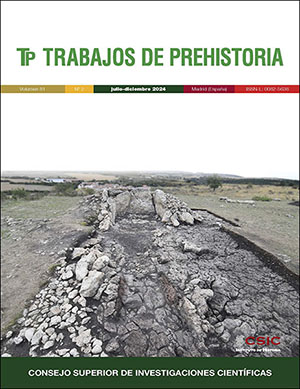
Vol. 81, 2, 2024: The Megalithic monument of El Pendón (Reinoso, Burgos). Photography: Research group of El Pendón.
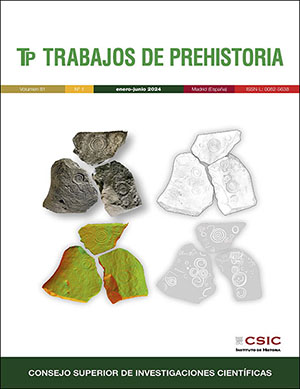
Vol. 81, 1, 2024: The Megalithic Group of Las Sileras (Córdoba). From top to bottom and from left to right: photographic reproduction with grazing light; conventional drawing; enhanced topographic map derivative map; digital tracing, white safe motifs, grey dubious identification. Composition by Victorino Mayoral from Martínez Sánchez et al., art. 966, figs. 3, 6 and 7.
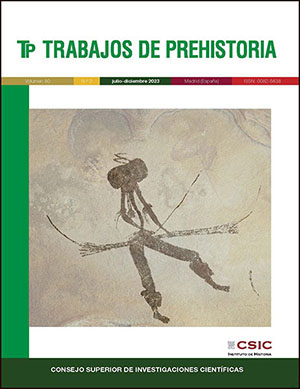
Vol. 80, 2, 2023: Tracing of the archer (motif 10) of the Estrecho del Regallo I shelter (Alcañiz, Teruel). Authors Manuel Bea, José Antonio Benavente, Jesús Carlos Villanueva and Jorge Angás.
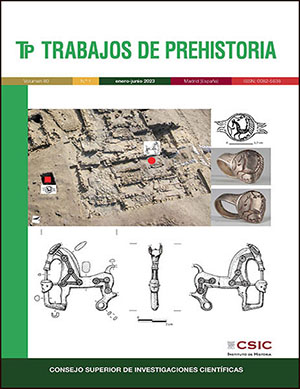
Vol. 80, 1, 2023: Cerro de la Mesa (Alcolea de Tajo, Toledo), aerial view of the excavation and location of the silver ring and the horse-and-rider fibula; silver ring (photo J. Pereira and Museo de Santa Cruz; drawing Almagro-Gorbea et al., 1999, fig. 2); horse-and-rider fibula (drawing Fernández and Castañeda “Dibujantes de Arqueología” and photos J. Pereira).
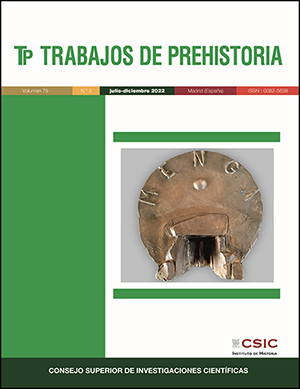
Vol. 79, 2, 2022: The bronze Menga Medal. Work of Francis Javier Galán of Mester Artis. Obverse: the entry façade of the Menga dolmen (Antequera, Málaga), projecting symbolically over the mound that covers the tomb (Díaz-del-Río et al., Fig. 10, p. 237).
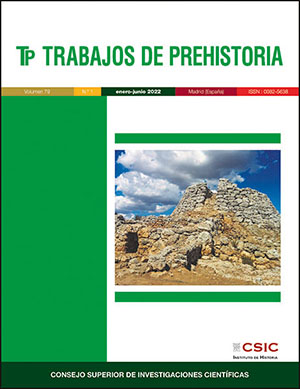
Vol. 79, 1, 2022: Talayot and South Building of Cornia (Mahón, Menorca) of the Late Bronze Age and Early Iron Age (José Simón Gornés Hachero, Fig. 3: 1, p. 102).

Vol. 78, 2, 2021: Detail of Plan and section of El Romeral tholos (Dryas Arqueologia Lda., Photographs: Javier Coca). By permission of Antequera Dolmens Site (Fig. 2, p. 279).
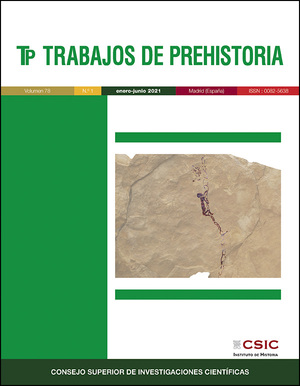
Vol. 78, 1, 2021: Barranco Gómez rock shelter (Castellote, Teruel). Detail of Panel 1: digital image of the honey hunting scene on the ceiling (Manuel Bea Martínez, Inés Domingo Sanz and Jorge Angás Pajas, Fig. 3: 1a, p. 168).
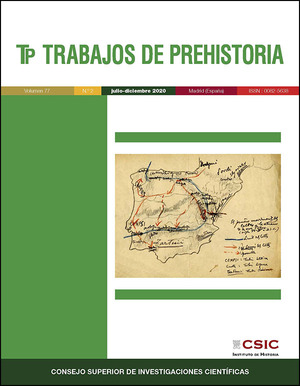
Vol. 77, 2, 2020: Hand drawn map of the movements of Celtic tribes made by Pere Bosch Gimpera for his classes (UB archive, Universitat de Barcelona) (Fig. 3 below, p. 248).
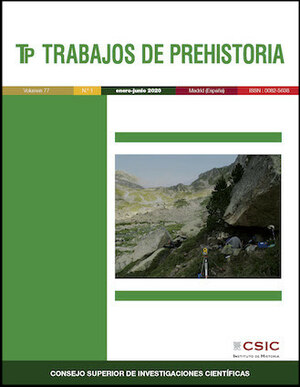
Vol. 77, 1, 2020: Abric de Les Obagues de Ratera (2320 m) during its excavation in 2015 (Fig. 1, p. 52).
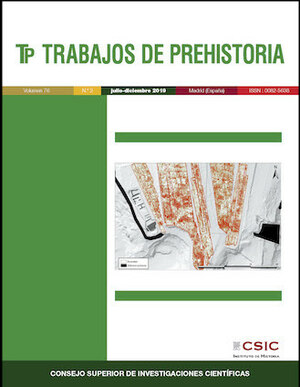
Vol. 76, 2, 2019: Hillfort of Villasviejas del Tamuja (Botija, Cáceres). Southern limit of the A enclosure, results of Ground penetrating Radar survey, which raises different hypotheses regarding the layout of the defensive wall (Fig. 8B, p. 314).
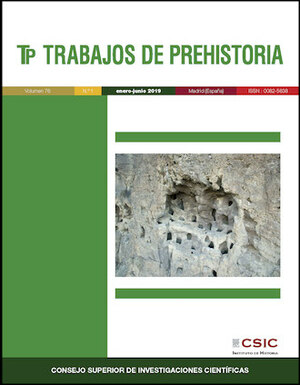
Vol. 76, 1, 2019: Lomo de la Cruz archaeological complex (Temisas, Gran Canaria): detail of the Risco Pintado granary (Tibicena Arqueología photography) (Fig. 2, p. 122).
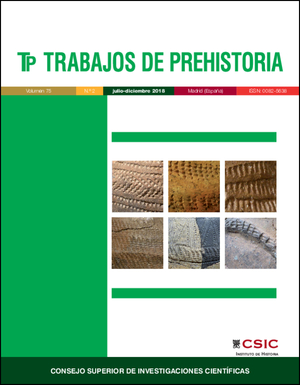
Vol. 75, 2, 2018: Detail of the Neolithic ceramic decoration from Cueva de Chaves. Photograph by Rafael Laborda Lorente (Fig. 11, page 260).
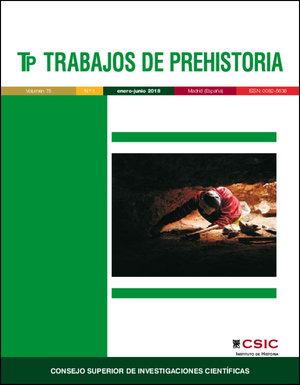
Vol. 75, 1, 2018: Early Neolithic flint mine of Casa Montero (Madrid, Spain). Example of one of the lateral excavations from Sampling Unit D4 that configure a real – although narrow – system of galleries (Fig. 7 below, p. 58).
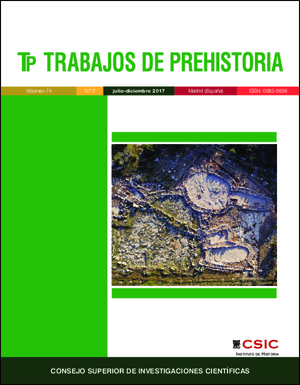
Vol. 74, 2, 2017: Cap Barbaria II (Formentera, Balearic Islands), air photograph April 2016 (Fig. 2A, page 323).
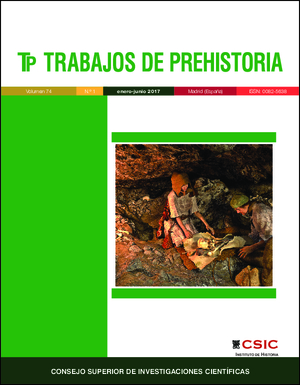
Vol. 74, 1, 2017: Reconstruction of a secondary burial event at El Rebollosillo (Torrelaguna, Madrid). Detail from an illustration by Pilar Cienfuegos in Consuegra and Díaz-del-Río (2013: 63). Reproduction courtesy of the Dirección General de Patrimonio Cultural, Oficina de Cultura y Turismo de la Comunidad de Madrid (Fig. 5, page 81).
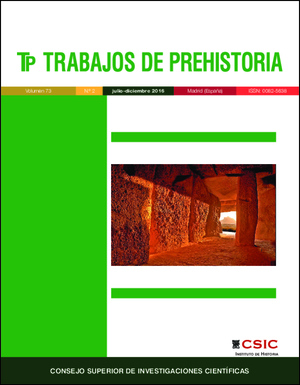
Vol. 73, 2, 2016: The sun enters the chamber of Menga, showing the passage graves orientation towards the Peña de los Enamorados (photograph by Javier Pérez González. Archivo del Conjunto Arqueológico Dólmenes de Antequera) (Fig. 1, p. 386).
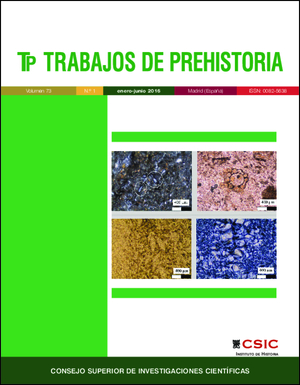
Vol. 73, 1, 2016: Microscopic view of geological thin sections from two chert types identified in Montlleó (Prats i Sansor, Lleida). Type 1: Charophyte algae with crossed polariser wiew (upp. left) and single polariser view (upp. right). Type 2: Lenticular gypsum pseudomporhs with crossed polariser view (low. left) and microquartz texture with chalcedony cementations (low. right) (Fig. 5, p. 15).
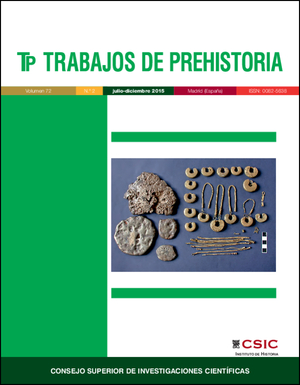
Vol. 72, 2, 2015: General view of the Recouso hoard on deposit in the Museo das Peregrinacións e de Santiago (with the exception of an earring now in the Museo Provincial de Lugo) (Fig. 2, p. 367).
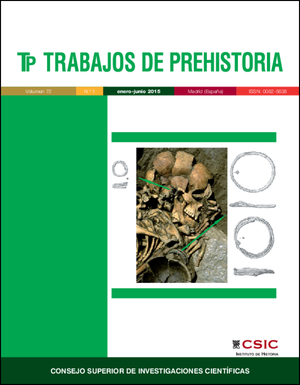
Vol. 72, 1, 2015: Detalle del enterramiento masculino de la sepultura 21 del Cerro de la Encina con indicación de la localización de 2 pulseras asociadas al radio-cúbito derecho y de un pendiente al hueso temporal. (Fig. 2, p. 131).
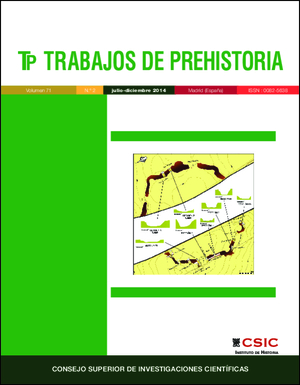
Vol. 71, 2, 2014: Planta general del foso del poblado calcolítico “Venta del Rapa” (Mancha Real, Jaén) con la localización de las secciones realizadas (Fig. 12, p. 356).
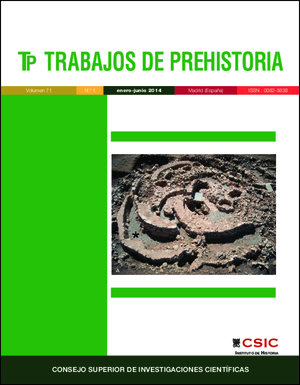
Vol. 71, 1, 2014: Castillejo del Bonete (Terrinches, Ciudad Real), vista aérea en 2012: desde el Norte, edificaciones sobre el acceso a la cueva (•) con el recinto que alberga la tumba 4 (*) (Fig. 6A, p. 80).
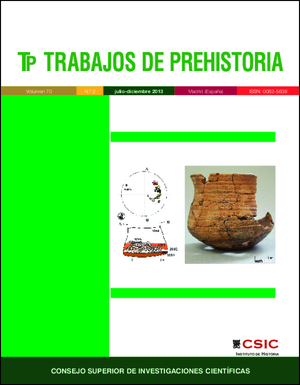
Vol. 70, 2, 2013: La Vital (Gandía, Valencia): enterramiento 10, correspondiente a un individuo femenino y Campaniforme Marítimo (variedad Herringbone) situado al otro lado de la estructura (Fig. 4, p. 268).
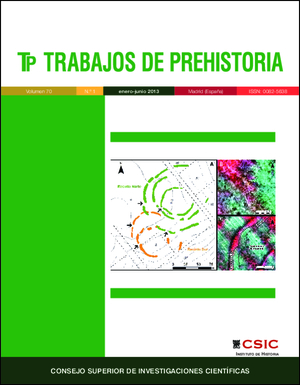
Vol. 70, 1, 2013: Las Pozas (Casaseca de las Chanas, Zamora): interpretación del trazado de los fosos detectados sobre el parcelario y posibles cabañas (Fig. 3, p. 179).
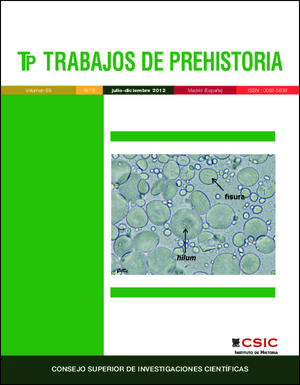
Vol. 69, 2, 2012: Granos de almidón del género Triticum al microscopio óptico (pág. 339).
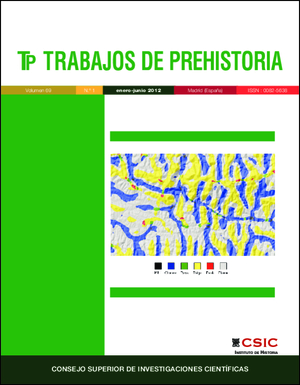
Vol. 69, 1, 2012: Example of the morphometric analysis carried out in western Sierra Morena (p. 110).
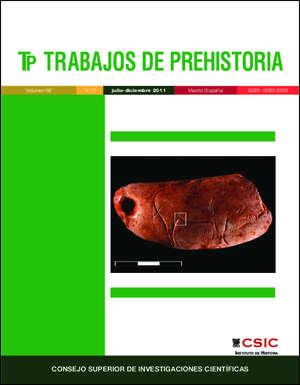
Vol. 68, 2, 2011: Diente de cachalote perforado con bisonte grabado (cueva de Las Caldas, Asturias, España) (foto Olivia Rivero, p. 281).
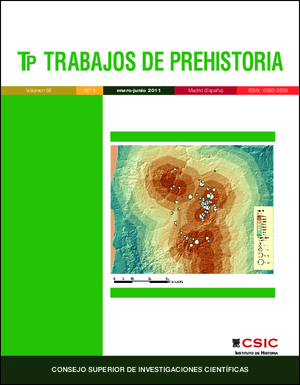
Vol. 68, 1, 2011: Proyecto de prospección de la Cuenca del Río Sado (Alentejo meridional, Portugal). Mapa con la distancia a los recursos de jaspe (Fig. 12, p. 40).
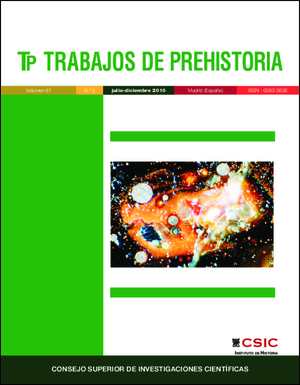
Vol. 67, 2, 2010: Escoria de cobre del yacimiento de la cultura Srubnaya de Gorny (Kargaly, Orenburgo, Rusia). Muestra PA6277. Microscopio óptico Reichert MeF3A, luz reflejada, campo oscuro, 200x (foto S. Rovira).
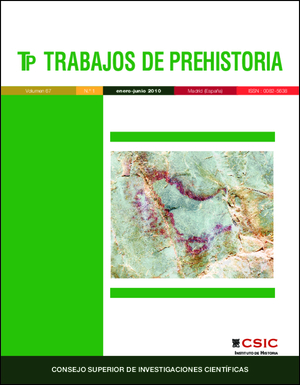
Vol. 67, 1, 2010: Detalle del caballo figura 4 del Conjunto 2 de la Grajera 2 (Lám. IV, p. 203).










